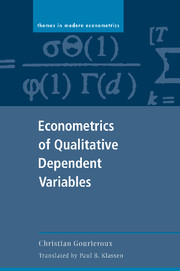Book contents
- Frontmatter
- Contents
- 1 Introduction
- 2 The Simple Dichotomy
- 3 Modelling
- 4 Estimation Methods and Tests
- 5 The Log-Linear Model and its Applications
- 6 Qualitative Panel Data
- 7 The Tobit Model
- 8 Models of Market Disequilibrium
- 9 Truncated Latent Variables Defined by a System of Simultaneous Equations
- 10 Simultaneous Equation Systems with Truncated Latent Variables
- 11 The Econometrics of Discrete Positive Variables: the Poisson Model
- 12 Duration Models
- Bibliography
- Index
1 - Introduction
Published online by Cambridge University Press: 05 June 2012
- Frontmatter
- Contents
- 1 Introduction
- 2 The Simple Dichotomy
- 3 Modelling
- 4 Estimation Methods and Tests
- 5 The Log-Linear Model and its Applications
- 6 Qualitative Panel Data
- 7 The Tobit Model
- 8 Models of Market Disequilibrium
- 9 Truncated Latent Variables Defined by a System of Simultaneous Equations
- 10 Simultaneous Equation Systems with Truncated Latent Variables
- 11 The Econometrics of Discrete Positive Variables: the Poisson Model
- 12 Duration Models
- Bibliography
- Index
Summary
Background
The study of models describing qualitative variables dates from the 1940s and 1950s (Berkson [Ber44], [Ber51]). Their initial applications were in the field of biology, followed by psychology and sociology. Only recently have these models been applied to economic data, where the development of qualitative models has taken two principal directions.
It has often been possible to construct models of individual behaviour based directly on the underlying economic theory. This approach has led to a better understanding of the significance of certain common models, e.g. the logit model (McFadden [McF74]). Furthermore, the modelling of certain economic phenomena (consumption of durable goods, disequilibrium analysis, etc.), though strictly speaking not of a qualitative nature, draws heavily on these models (cf. Tobin [Tob58], Fair-Jaffee [FJ72] and Heckman [Hec76]).
The second development has been the introduction of exogenous variables to explain the values assumed by the qualitative variable. The primary role of these models is explanatory. It is natural to compare these explanatory models to the traditional linear formulation.
Review of Qualitative Variables
Generalities
Statistical data available to the researcher often reflect qualitative characteristics of the study subjects, such as: socio-economic class, field of education, employment status, whether or not they have purchased a certain good, etc. Inference from this data requires an entirely different set of tools from those applied to the more typical quantitative data, as the former is characterized by its discrete nature and, frequently, the absence of a natural order.
Information
- Type
- Chapter
- Information
- Econometrics of Qualitative Dependent Variables , pp. 1 - 5Publisher: Cambridge University PressPrint publication year: 2000
